Dharma companions is a blog focusing on Dharma activities, information dissemination and bringing awareness to the multifaceted aspects of Buddhism for the community from Shah Alam Buddhist Society (SABS). Postings should be of interest to Buddhist and anyone who seeks information on Buddhism. As the title suggest, we also aim to be a companion to those who seeks our company in this path that we undertake. May you be well, happy and peaceful.
Saturday, November 5, 2016
Buddhist master's condition stable after stroke
2016/11/02 Focus Taiwan

Taipei, Nov. 2 (CNA) Master Hsing Yun (星雲法師), founder of Fo Guang Shan, an international Buddhist religious movement, was in stable condition Wednesday after brain surgery following a stroke, Kaohsiung Chang Gung Memorial Hospital said that day.
Chen Chao-lung (陳肇隆), convener of the hospital's medical team, said that Hsing Yun suffered a hemorrhagic stroke and doctors removed a fist-size blood clot from his brain Oct. 31 in a procedure that lasted three hours and 25 minutes.
He said that Hsing Yun developed the symptoms of drowsiness, vomiting and weakness after he returned from an overseas preaching mission Oct. 29, and was taken to the hospital the following day.
The master is now conscious, but as he is 90 years old, suffered two ischemic strokes in 2011, and has a medical record of high blood pressure, high blood sugar and high cholesterol, he will have to remain in the hospital for a few more days.
"The hospital is cautiously optimistic about his condition, but it remains to be seen when he will be able to be discharged," Chen said.
Meanwhile, the operations of Fo Guang Shan, located in Kaohsiung and the largest monastery in Taiwan, are proceeding normally.
Many of the followers and visitors to the monastery said that they only learned about the master's hospitalization from media reports.
(By Chen Che-fon and Lilian Wu)

Taipei, Nov. 2 (CNA) Master Hsing Yun (星雲法師), founder of Fo Guang Shan, an international Buddhist religious movement, was in stable condition Wednesday after brain surgery following a stroke, Kaohsiung Chang Gung Memorial Hospital said that day.
Chen Chao-lung (陳肇隆), convener of the hospital's medical team, said that Hsing Yun suffered a hemorrhagic stroke and doctors removed a fist-size blood clot from his brain Oct. 31 in a procedure that lasted three hours and 25 minutes.
He said that Hsing Yun developed the symptoms of drowsiness, vomiting and weakness after he returned from an overseas preaching mission Oct. 29, and was taken to the hospital the following day.
The master is now conscious, but as he is 90 years old, suffered two ischemic strokes in 2011, and has a medical record of high blood pressure, high blood sugar and high cholesterol, he will have to remain in the hospital for a few more days.
"The hospital is cautiously optimistic about his condition, but it remains to be seen when he will be able to be discharged," Chen said.
Meanwhile, the operations of Fo Guang Shan, located in Kaohsiung and the largest monastery in Taiwan, are proceeding normally.
Many of the followers and visitors to the monastery said that they only learned about the master's hospitalization from media reports.
(By Chen Che-fon and Lilian Wu)
What Zen “Acceptance” and “Non-Attachment” Really Are
September 6, 2016 by Domyo Burk
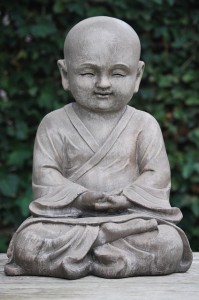 The practices of acceptance and non-attachment are critical to Zen and Buddhist practice – but they are easily misunderstood.
The practices of acceptance and non-attachment are critical to Zen and Buddhist practice – but they are easily misunderstood.
It can sound like we’re being asked not to care about things, or not to try to change things for the better. Fortunately, this is not what Zen means by acceptance or non-attachment, because 1) it’s impossible (or psychologically and spiritually damaging) not to care, and 2) trying to change things for the better is the bodhisattva path itself!
So what does it mean to practice acceptance and non-attachment?
Story of Buddhism
This is the story of Buddhism with extensive captions from Sumedha's aspiration, through the last birth and the spread of Buddhism, especially as it pertains to Myanmar.


Labels:
History
Location:
Shah Alam, Selangor, Malaysia
Friday, November 4, 2016
An Agent of Change: Empowering Bhutanese Nuns
By Craig Lewis Buddhistdoor Global 2016 Aug 12
Nestled between China and India on the eastern edges of the mighty Himalayas, the tiny Buddhist Kingdom of Bhutan is remarkable for a number of reasons. Perhaps best known for prioritizing “Gross National Happiness” over the shortsighted acquisitiveness of economic growth and for its sustainable approach to environmental stewardship, the kingdom is also unique in being the only Himalayan country in which Vajrayana Buddhism has existed as an unbroken spiritual tradition since the 8th century.
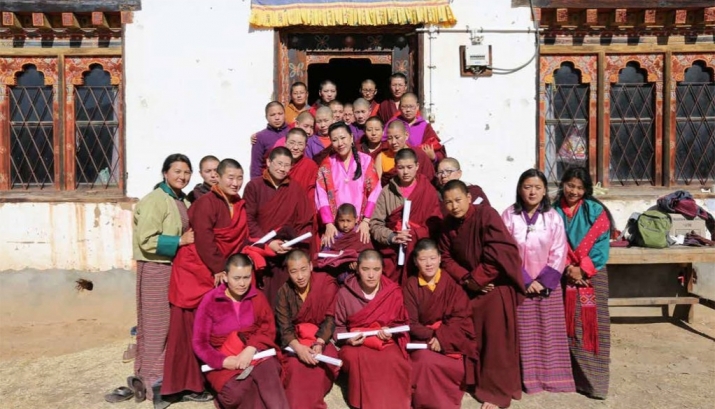 Her Majesty, the Queen Mother, Ashi Tshering Yangdon Wangchuck, center, and Bhutan Nuns Foundation executive director Dr. Tashi Zangmo, far left, pose with some of the nuns who have received education and training thanks to the BNF. Image courtesy of the Bhutan Nuns Foundation
Her Majesty, the Queen Mother, Ashi Tshering Yangdon Wangchuck, center, and Bhutan Nuns Foundation executive director Dr. Tashi Zangmo, far left, pose with some of the nuns who have received education and training thanks to the BNF. Image courtesy of the Bhutan Nuns FoundationThe Cultivation of Wholesome Mental States - Sayadaw U Pandita.
"If you can be perfect in precepts, you may appear to be a very
holy person, but inside you may be still tortured by eruptions of
impatience, hatred, covetousness, and scheming.
impatience, hatred, covetousness, and scheming.
Therefore, the next step is bhavana, which means in Pali 'the
cultivation of exceptionally wholesome states.'
cultivation of exceptionally wholesome states.'
The first part of bhavana is to prevent unwholesome states
from arising.
from arising.
The second part is the development of wisdom in the absence
of these states."
of these states."
In This Very Life, Kandy: BPS, 1991 (p.49)
Labels:
Teacher,
Understanding
Location:
Shah Alam, Selangor, Malaysia
Muni Sutta (Sn 1.12)
Labels:
Understanding
Location:
Shah Alam, Selangor, Malaysia
Saint and freedom fighter of Sri Lanka
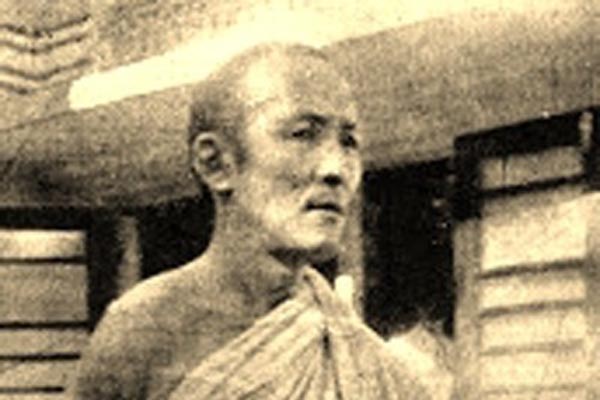
Ven S Mahinda, known in Sri Lanka as Venerable Tibet Jathika S Mahinda Himi. Photographer unknown
By Laden Tshering Samdup KATHMANDU, Nepal, 24 October 2016
Many would be surprised to hear that a Tibetan had become a Theravada monk.
Labels:
Inspirational
Location:
Kathmandu 44600, Nepal
Thursday, November 3, 2016
A Buddhist US Army’s Chaplain Candidate on the election
My name is Robert McCarthy, my dharma name is Shuken Ju-Etsu, the meaning is “kind humble and goes beyond,” I would say that these elements are reflected in both my spiritual and secular life. I was born and raised in Western Michigan in a fairly conservative working class town. I am currently enrolled at the University of the West’s Masters of Divinity program learning to be a chaplain, with the ultimate goal to find employment in either the US Army or a hospice program.
Cleaning kuti, Cleaning mind!
Keeping our kuṭis, our dwelling places, in order helps to keep our minds in order as well. So anytime we leave our kuṭis, we should make sure everything is put away, neat and tidy.

Labels:
Skillful Practice,
Teacher
Location:
Shah Alam, Selangor, Malaysia
Brahma Faring in 21st-Century Mazes, by Sylvia Swain
Posted on 1 November 2013 by Buddhism Now
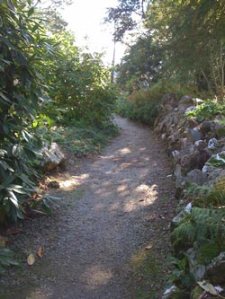 We human beings are all farers through life and will traverse pathways of many different kinds — tranquil woodland paths, busy city streets, highways, byways, even soulless, preoccupied motorways. Late and in a traffic jam, one mood can trigger another, taking us into an emotional turmoil of frustration, anxiety, anger, and enter into a different kind of transport which carries us away to involuntary destinations. So much for bodily as well as emotional journeys!
We human beings are all farers through life and will traverse pathways of many different kinds — tranquil woodland paths, busy city streets, highways, byways, even soulless, preoccupied motorways. Late and in a traffic jam, one mood can trigger another, taking us into an emotional turmoil of frustration, anxiety, anger, and enter into a different kind of transport which carries us away to involuntary destinations. So much for bodily as well as emotional journeys!
Location:
Shah Alam, Selangor, Malaysia
SN 56.37 (Suriyūpamasuttaṃ)
Labels:
Understanding
Location:
Shah Alam, Selangor, Malaysia
Wednesday, November 2, 2016
What does it mean to be enlightened? Bhikkhu Bodhi
In a conversation with an aged brahmin, the Buddha once explained concisely what is meant by a Buddha, an enlightened one:
“What has to be known, that I have known;
What has to be abandoned, that I have abandoned;
What has to be developed, that I have developed;
Therefore, O brahmin, I am a Buddha.”
Labels:
Teacher,
Understanding
Location:
United States
Dharma and Relationships in Bhutan: A Brief and Very Partial Trip Review
October 28, 2016 by Dosho Port
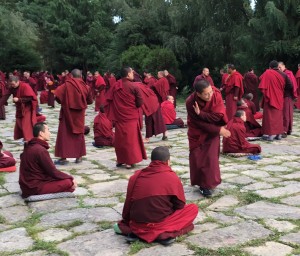 One night earlier this month at Lhodrak Karchu Monastery in Jakar, in the Bumthang district of Bhutan (the photo on the left is of monks there practicing debate), I set out for dinner at the cafeteria where the 80 or so mostly Western conference participants received meals. The cafeteria was four blocks from my dorm, down a winding road where I knew I was likely to pass a dozen or so friendly (or, at least, neutral) stray dogs who roamed the country, including the grounds of the monastery and sometimes the hallway of the dorm. During my jaunt to lunch, in addition to stray dogs, I had also met a handful of Jersey cows, moseying along, checking me out, and then returning to munching whatever they could find.
One night earlier this month at Lhodrak Karchu Monastery in Jakar, in the Bumthang district of Bhutan (the photo on the left is of monks there practicing debate), I set out for dinner at the cafeteria where the 80 or so mostly Western conference participants received meals. The cafeteria was four blocks from my dorm, down a winding road where I knew I was likely to pass a dozen or so friendly (or, at least, neutral) stray dogs who roamed the country, including the grounds of the monastery and sometimes the hallway of the dorm. During my jaunt to lunch, in addition to stray dogs, I had also met a handful of Jersey cows, moseying along, checking me out, and then returning to munching whatever they could find.Dhammapada 192 (translated by Gil Fronsdal)
Labels:
Dhammapada
Location:
Shah Alam, Selangor, Malaysia
Tuesday, November 1, 2016
10 Misconceptions about Buddhism (#10)
This article is the tenth in the 10 Misconceptions about Buddhism series with scholars Robert E. Buswell Jr. and Donald S. Lopez Jr.
One Way to Nirvana
It’s not just the Buddha Way that’s different—the Buddhist mountaintop is different, too. JUL 03, 2014

Many think of Buddhism as a tolerant religion, one that recognizes the value of all religious traditions. In recent years, there have been growing numbers of Buddhist-Christian dialogues and Buddhist-Jewish dialogues. The Dalai Lama has even commented on the gospels. This might suggest that Buddhism holds that all religions are one, that all spiritual paths lead to the same mountaintop. Nothing could be further from the truth.
Dhammapada 40 (translated by Gil Fronsdal)
Labels:
Dhammapada
Location:
Shah Alam, Selangor, Malaysia
A training rule for the bhikkhus with ten aims

Vinaya: for the well beings of the community and of an individual monastic
Labels:
Teacher,
Understanding
Location:
United States
When one does not understand death, life can be very confusing
Labels:
Teacher,
Understanding
Location:
Shah Alam, Selangor, Malaysia
Monday, October 31, 2016
Chanting by US Ajahns
សូមស្តាប់ព្រះសង្ឃគង់នៅតំបន់ពាយព្យ (Northwest Canada- USA).សូត្រធម៌ម្តង។ Abhayagiri Monastery (Fearless mountain) Redwood, CA Oct-23-2016.
Blessing chant by a sangha which includes many of the senior US Ajahns at the recent Kathina in Abhayagiri in California .
https://www.facebook.com/kunmealy.malai/videos/1817867638484833/
Blessing chant by a sangha which includes many of the senior US Ajahns at the recent Kathina in Abhayagiri in California .
https://www.facebook.com/kunmealy.malai/videos/1817867638484833/
Labels:
Chanting,
Inspirational,
Video
Location:
California, USA
Warning!
Labels:
Announcement
Location:
Shah Alam, Selangor, Malaysia
Why we need Others to become Enlightened
Lama Surya Das Oct 18, 2016 Elephant Journal.

What does spirituality mean when external things are stripped away: no holy robes, no pews or meditation cushions, no songs to sing or candles to light, no offerings to burn and no mantras to recite, no how-to books and New Age jargon?
60 Years of the Indian Buddhist Revival
October 25, 2016 by Justin Whitaker A guest post by David Viradhamma Creighton
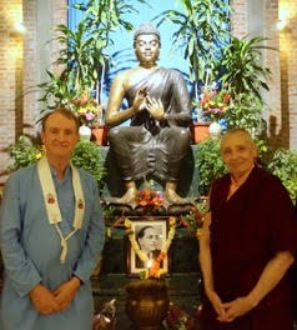 David Creighton with Ven. Tenzin Palmo – photo by David Creighton
David Creighton with Ven. Tenzin Palmo – photo by David CreightonOn October 11, 1956 the leader of India’s “untouchable” community stood before 400,000 of his followers in the city of Nagpur and led them in a mass conversion to Buddhism. Dr. Bhimrao Ambedkar had tried for decades to reform Indian society and end caste discrimination using legal and political tools, but he had come to the conclusion that the only hope for his oppressed people was to embrace a religion that denied caste and celebrated personal freedom and social justice.
Thich Nhat Hanh 90th birthday photo
October 12, 2016 by Justin Whitaker
The beloved Vietnamese Zen teacher Thich Nhat Hanh turned 90 yesterday. He has been living peacefully at his retreat center in the south of France after a stroke nearly two years ago set off a long and steady period of recovery, partially spent in the care of expert physicians in the US.
All has been quiet from Thich Nhat Hanh and his students in France in recent months, but yesterday this photo of him enjoying a meal surrounded by friends circulated on Reddit.
As one commenter there writes, “Seeing all those smiling faces, i couldn’t help but smile too. I feel the metta. Happy birthday Thay. Metta and mudita.”
Indeed, a great light in the world continues to shine and the resulting smiles continue to spread around the world.
Vietnamese families transform former Methodist church into Buddhist temple
By Rebecca R. Bibbs, The Herald Bulletin, Oct 22, 2016Anderson, IN (USA) -- Madison County’s religious landscape stands poised to broaden Sunday with the grand opening ceremony of the Chua Pho Minh Buddhist temple.  The temple, 4100 Main St., Anderson, is founded by several Vietnamese families and is named in honor of temples of the same name in Tuc Mac, Vietnam, and Sacramento, Calif. The original temple was built during Vietnam’s Tran Dynasty in the 13th century. The temple, 4100 Main St., Anderson, is founded by several Vietnamese families and is named in honor of temples of the same name in Tuc Mac, Vietnam, and Sacramento, Calif. The original temple was built during Vietnam’s Tran Dynasty in the 13th century.Diep Laughlin, one of the founding members of the Anderson temple, which will include a monastery, said it was the dream of El Cerrito, California-based the Rev. Anna Dao, who wanted to expand her ministry. She bought the 1.27-acre property, which was listed in the Madison County Sheriff’s auction with an asking price of more than $207,000, in March 2015. |
Labels:
Announcement,
Inspirational,
Location
Location:
Anderson, IN, USA
Sunday, October 30, 2016
Happy
Labels:
Teacher,
Understanding
Location:
Shah Alam, Selangor, Malaysia
Everything belongs!
"To establish the attitude of loving-kindness—the genuine heart of mettā—is to establish within ourselves a heart of non-contention, a heart that is accepting and accommodating of all mind states. This doesn’t mean to say that we are approving of every thought we have, or that all our feelings of selfishness, violence, aggression, jealousy, and fear are beautiful, wonderful adornments for the world. We’re not trying to pretend or allow ourselves to get lost in delusion, confusing the skillful and unskillful. Instead we’re simply trying to recognize that everything belongs, whether it’s a noble and wholesome thought, or a selfish, fearful, jealous, or greedy thought. They all belong. They’re all attributes of nature. When we cultivate this quality of non-contention and acceptance toward all our inner qualities—feelings, thoughts, perceptions, memories, ideas, and fantasies—then the heart is not divided, and there’s unity, a unification of the heart. Without this fundamental unity of mettā in our hearts— this fundamental welcoming inclination and recognition that our internal attributes, good or bad, are all aspects of the natural order—it’s impossible to have a genuine, substantial attitude of loving-kindness toward others, because the heart is divided."
- Ajahn Amaro
Labels:
Teacher,
Understanding
Location:
United States
Theragatha 2.13
Labels:
Understanding
Location:
Shah Alam, Selangor, Malaysia
Buddhist Economics for a Better World
Posted on by ayyayeshe
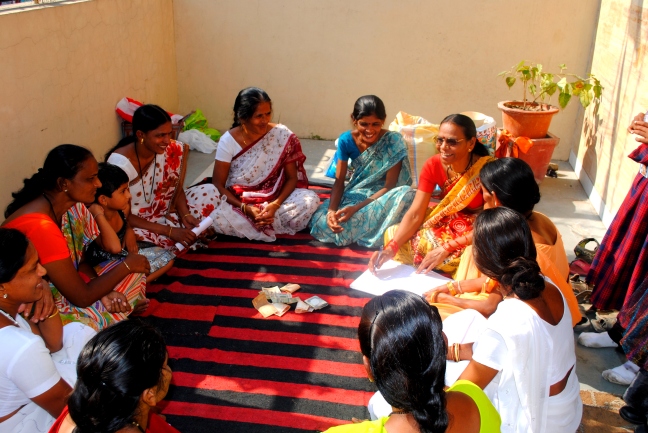

If the Buddha was an enlightened financial advisor, how would he recommend we make money and make the world a better place at the same time?! Money and true spirituality are often thought to exist in two completely different spheres. But if we are to be socially engaged Buddhists who have high ideals, pursue awakening, but also make a living in the world and try to benefit it, some enlightened though is needed in the area of spiritual economics. The Buddha did give some advice on how to deal ethically with money in the sutras – he said keep some of your money to re-invest in your business, support your parents/family/ relatives and the needy. Give some to holy persons who are practicing the spiritual path and save the rest.
Subscribe to:
Comments (Atom)



















